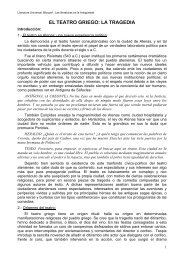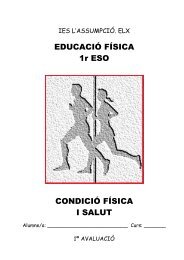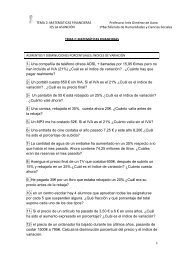EXERCICIS DE DERIVADES - IES La Asunción de Elche
EXERCICIS DE DERIVADES - IES La Asunción de Elche
EXERCICIS DE DERIVADES - IES La Asunción de Elche
Create successful ePaper yourself
Turn your PDF publications into a flip-book with our unique Google optimized e-Paper software.
1BAT CCNN<strong>EXERCICIS</strong> <strong>DE</strong> <strong>DE</strong>RIVA<strong>DE</strong>SDefinició <strong>de</strong> <strong>de</strong>rivada. Recta tangent.1. Calcula la taxa <strong>de</strong> variació mitjana <strong>de</strong> la funció f(x) = x 2 − 2x + 1 en l’interval [−1, 2] il’equació <strong>de</strong> la recta secant al gràfic que passa pels punts d’abscisses x = −1 i x = 2.2. Calcula les TVM <strong>de</strong> les següents funcions als intervals indicats:⎡ π⎤a) f(x) = cos x, en⎢0 ,⎣ 3⎥⎦b) g(x) = 2 − x , [−2, 0]3. Calcula la taxa <strong>de</strong> variació instantània <strong>de</strong> la funció f(x) = 2x 2 − 3x + 1 en x = −1.4. L’altura, en metres, abastada al cap <strong>de</strong> t segons per un projectil llaçat verticalment capamunt ve donada per la funció f(t) = 20t − 2t 2 . Troba la velocitat mitjana en l’interval<strong>de</strong> temps comprés entre t = 0 i t = 5 segons.5. <strong>La</strong> distància recorreguda per un autobús en els cinc primers segons <strong>de</strong>s <strong>de</strong> que ix <strong>de</strong> laparada ve donada per la funció f(t) = t 2 .a) Calcula la velocitat mitjana entre els instants t = 3 s i t = 3,1 s.b) Quina és la velocitat <strong>de</strong> l’autobús en l’instant t = 3 segons?6. Calcula, aplicant la <strong>de</strong>finició, la <strong>de</strong>rivada <strong>de</strong> les següents funcions per als valors <strong>de</strong> xindicats:a) f(x) = x 3 , quan x = 1b) f(x) = x 2 + 5x − 2, quan x = −2c) f(x) = x + 2 , quan x = 22xd) f(x) =x − 3, quan x = 67. Escriu l’equació <strong>de</strong> la recta tangent per a cada una <strong>de</strong> les funcions <strong>de</strong> l’exercici 5 en elspunts indicats.1P ⎜ .⎝ 21 ⎛ ⎞8. Obtín l’equació <strong>de</strong> la recta tangent al gràfic <strong>de</strong> la funció f(x) = en el punt 2, ⎟ x ⎠Continuïtat i <strong>de</strong>rivabilitat9. Quina és l’equació <strong>de</strong> la recta tangent al gràfic <strong>de</strong> la funció f(x) = x en x = 0?⎧ x10. 2 + 1Es consi<strong>de</strong>ra la funció f(x) = ⎨⎩−x + 3a) És f continua en x = 1?b) Comprova que no existeix f ′(1)c) Existeix recta tangent en P(1, f(1))?si x ≤ 1si x > 11
1BAT CCNN11. Observa el gràfic <strong>de</strong> la funció y = f(x)i digues el signe <strong>de</strong> la <strong>de</strong>rivada en:x = 0, x = 2, x = 4.YOXf12. Estudia la continuïtat i la <strong>de</strong>rivabilitat <strong>de</strong> les següents funcions en els punts indicats:22⎧x+ 1 si x > 0⎧xsi − ∞ < x ≤ 0⎪⎪ 1a) f(x) = ⎨1si x = 0 en x=0 b) f(x) = ⎨ si 0 < x < 1 en x=0 i x=1⎪ 2⎩ 1 − x si x < 0⎪ x2⎩ x si 1 ≤ x < +∞⎧ kx − 5 si x ≤ 013. Calcula k perquè la funció f(x) = ⎨siga <strong>de</strong>rivable en x = 0.3⎩x− 3x − 5 si x > 0Càlcul <strong>de</strong> <strong>de</strong>riva<strong>de</strong>s14. Troba la funció <strong>de</strong>rivada <strong>de</strong> les funcions:x 2a) y = 5x 3 b) y = − c) y = 2 x d)8e) y = 2 x f) y = π x g) y = 2.ln x h)y =y =3xln x315. Calcula la <strong>de</strong>rivada <strong>de</strong> les següents funcions:23x 32a) y = x − 3x + 2 b) y = + 4 x − c) y = 6x − 3ln x + 2 x2 x3 2 2d) y = (x + 3x )( −x+ 6x − 2)e) y = (2x − 7)(5 − 3x)f) y = 2 x.ln xg)2x −1= h)x + 1y22 xy = i)x + 316. Deriva les següents funcions aplicant la regla <strong>de</strong> la ca<strong>de</strong>na:3x + 2x=x − 5y2a) y = 3x − 2b) y = ln(3x2 + 4)c) y = ln x2 − 2xd)y +2 3= (x 2x) e) y (3x + 5)3 −1y = x − xh)2g) ( ) 32⎛ x − 2 ⎞= f) y = ln⎜⎟2⎝ x + 2 ⎠2⎛ 3x − 4 ⎞y = ⎜ ⎟ i) y = 3x2 − 5x⎝ x −1⎠2
1BAT CCNN17. Calcula la <strong>de</strong>rivada <strong>de</strong> les següents funcions potencials i exponencials:4a) y = 3 3 2xb) y = 4 x − 3 x + x +x1 c) y =2xx + 1d) 3x2xy = e) y = 2f) y = 52x + 1g)y23−x= eh)y+ 4x= 4i)18. Calcula la <strong>de</strong>rivada <strong>de</strong> les següents funcions trigonomètriques:x 2y = x2a) y = sin 2xb) y = cos(2x + 1)c) y = cos(3x + 4x − 1)d) y = x.cos 2xe) y = ln (sin x)f) y = sin x.cos 2xxg) y = e . tgxh) y = tg(2x2 + x)i) y = tg(sin x)3.2x.ex3 23 3 2j) y = sin (x − 4)k) y = x .tg (x − x)l)y = e−x.sin x319. Calcula la <strong>de</strong>rivada <strong>de</strong> les següents funcions logarítmiques:23a) = log xb) y = log (3x 1)c) y = ln(x − 2x + 1)y3d) y = 5x.log xe)2−y +2 x2= ln x e f) y = ln (6x + 4)20. Calcula la <strong>de</strong>rivada <strong>de</strong> les següents funcions potencial-exponencials:a)yx+1= xb)y2x+3= (3x + 1)c)xy = (sin x)d)sin 3xy = xe)sin xy = (sin x)f)y = (x +ln x)x21. Calcula la <strong>de</strong>rivada <strong>de</strong> les següents funcions trigonomètriques inverses:a) y = arc sin 2xb) y arc cos(x2 2= + 1)c) y = arc tg(3x )xd) y = arc sin(e ) e) y = arc cos x f) y = ln(sin x + arc sin x)22. Deriva les següents funcions simplificant al màxim el resultat:a)1 − sin xy = b)1 + sin x21 − cos x2x= lnc) y = − 4 1 + x1 + cos x1 + xy22d) y = ln(x . 1 − 2x ) e) y ln(x + x2 −1)x 2x= f) y = ln( e + e −1)2xx1 − xg) y = arc tgh) y = arc tgi) y = arc tg21 − x21 − x1 + x21 + xln(x − 9) 1 x − 3j) y = arc tg − arc tg xk) y = + ln1 − x2 6 x + 3xl) y 4 x2 2 2 2 x= − + 2.arc sinm) y = x. a − x + a .arc sin2a3
1BAT CCNNAplicacions <strong>de</strong>riva<strong>de</strong>s23. Calcula les rectes tangent i normal a les següents corbes en els punts indicats:πxa) y = ln(tg2x)en x = b) y = en x = 4.8 x2 + 924. <strong>La</strong> recta tangent a una corba en un punt pot tallar a la corba en altre punt. <strong>La</strong> tangent a la corbaf(x) = x 3 en T(1, 1) la talla en un altre punt. Quin és?x25. Calcula les tangents a la corba y = que formen un angle <strong>de</strong> 45 o amb la part positiva <strong>de</strong>21 − xl’eix OX.26. En quins punts <strong>de</strong> la corba y = 2 + x − x 2 la tangent:a) és horitzontal? b) té per pen<strong>de</strong>nt 2?27. Troba en quin punt la recta tangent a la corba y = ln 3 (2x) és paral·lela a l’eix d’abscisses.28. Troba l’equació <strong>de</strong> la recta tangent a la paràbola y = x 2 − 5x + 6 paral·lela a la recta3x + y − 2 = 0.29. En quin punt <strong>de</strong> la corba f(x) = ln x la tangent és paral·lela a la corda que uneix el punts(1, 0) i (e, 1)?30. Calcula l’àrea <strong>de</strong>l triangle format per els eixos <strong>de</strong> coor<strong>de</strong>na<strong>de</strong>s i la recta tangent a la2hipèrbola y = en el punt d’abscissa x = 1.x31. Troba el valor <strong>de</strong> c perquè el mínim <strong>de</strong> la funció f(x) = x 2 + 2x + c siga igual a 8.32. <strong>La</strong> funció f(x) = x 3 + ax 2 + b té un mínim relatiu en el punt P(2, 3). Troba els nombres a i b.33. <strong>La</strong> corba d’equació y = x 2 + bx + c passa pel punt A(−2, 1) i té un extrem relatiu en el puntd’abscissa x = −3. Troba els nombres b i c.34. Calcula els extrems relatius, els intervals <strong>de</strong> creixement i <strong>de</strong>creixement, els punts d’inflexiói els intervals <strong>de</strong> curvatura <strong>de</strong> les següents funcions:4 23x2 + 1a) y = x − 2xb) y = 4x − 5x + 1 c) y =x22x + 1x −1xd) y = e) y = f) y =22x −1x − 21 + xxxg) y = e .(x −1)h) y = x ⋅ei) y = ln(x2 + 1)j)yx= x ⋅ ek)1ln xy = l)x35. Representa gràficament les següents funcions:33 2a) y = (x + 1)b) y = x − 6x + 9xc)4 2x + 1d) y = −x+ 2x −1e) y = f)x − 3xey =x4y = 3x − 4xy 1=x2 + 13− 12x24
1BAT CCNNxg) y = h)21 + xxy = i)x2 −1y =2xx −1Problemes d’optimització36. Descompon el nombre 25 en dos sumands tals que el doble <strong>de</strong>l quadrat <strong>de</strong>l primer mésel triple <strong>de</strong>l quadrat <strong>de</strong>l segon siga mínim.37. Calcula les dimensions <strong>de</strong>l major rectangle <strong>de</strong> perímetre 40 m.38. Un pastor vol tancar un camp rectangular <strong>de</strong> 3600 m 2 <strong>de</strong> superfície per fer una pleta.Indica les dimensions perquè el cost siga mínim?39. Un nombre més el quadrat d’un altre sumen 48. Com han <strong>de</strong> triar-se eixos nombresperquè el seu producte siga màxim?40. Es vol tancar un camp rectangular que està a la vora d’un camí. Si la tanca <strong>de</strong>l costat <strong>de</strong>lcamí costa 80 €/m i la <strong>de</strong>l altres costats 10 €/m, troba les dimensions <strong>de</strong>l camp ambmajor àrea que es pot envoltar amb 28800 euros.SOLUCIONS1. TVM f [−1,2] = −1 ⇒ y = −x + 332. a) TVM f [0,π/3] = 2π3. TVI f (−1) = −74. 10 m/s5. a) v m = 6,1 m/s b) v i = 6 m/s6. a) f (1) = 3′ b) f ′(−2)= 1 c)7. a) y = 3x − 2 b) y = x − 6 c)x48. y = − + 1b) TVM g [−2,0] =2 − 2212f ′(2)= d) f ′(6)= −43x 3 2y = + d) y = − x + 84 2 39. No hi ha recta tangent en x = 0 ja que f −′ (0) = −1≠ f +′ (0) = 110. a) Sí, ja que lim f (x) = f (1) 2f (1) = 2 ≠ f ′ (1) = −111. f (0) > 0=x →′+b) No existeix ja que − 1 c) No, ja que no és <strong>de</strong>rivable en x=1′ ; f ′(2)= 0 ; f ′(4)< 012. a) Continua i <strong>de</strong>rivable en x = 0 b) En x = 0 no és continua ⇒ tampoc és <strong>de</strong>rivable; En x = 1 és continua però no és<strong>de</strong>rivable13. k = −314. a)2y ′ = 15x b)xy′ = − c) y ′ = 2 d)43y′ = − e)2x1y ′ = f) y ′ = π g)x2y ′ = h)xy ′ =13x5
1BAT CCNN15. a) y = 3x2 − 316. a)f)17. a)′ b)32+ (x + 3x )( −2x+ 6)=g)4xy′ = h)2 2(x + 1)3y′ = b)2 3x − 22 3y ′ = x + + c)2x x433 122y ′ = 12x − + d) y′ = (3x + 6x)( −x+ 6x − 2)+x x2− 5x + 12x + 12x + 24x e) y ′ = −12x+ 36 f)3 − xy′ =i)2x (x + 3)6xy′ = c)3x2 + 4y′ =2xg)x4ln.(x − 4)2x 2⎝ + ⎠⎛⎜2− 2 ⎞⎟11 2y ′ = b) y′ = − + 1 c)3 24 3 33 x4 x x2xf) y′ = 2.5 .ln 5 g)xy′=4−17x(x22− 5)−102ln xy ′ = +xx −12 2y′ = d) y′ = 3(x + 2x) (2x + 2)e)x2 − 2x23(x − x)(2x −1)y′ =h)22 x − x23−xy7y′ = − d)2 4 34x xx 2 + 4x′ +y′ = −2x.eh) y = 4 .ln 4.(2x 4)2(3x − 4)′2 xxy′=29(3x + 5)(3x + 5)32−1′ =3(x −1)i) y =⋅⎜6x− ⎟ 2⎝ 2 5x ⎠223x1−5xy′ =1 − 2x − xxe) y′= 2 .ln 22⎛ x + 1 ⎞32 23 ⎜ ⋅ (x + 1)2⎟⎝ x + 1⎠2xxi) y′= x .2 .e (3 + x.ln 2 + x)218. a) y ′ = 2.cos2xb) y ′ = −2.sin(2x+ 1)c) y′ = −(6x+ 4).sin(3x + 4x −1)d) y′= cos2x − 2x.sin 2xcosxx 2 x sin x.cos x + 1e) y ′ = f) y′ = cos x.cos2x − 2.sin x.sin 2xg) y′= e (1 + tgx + tg x) = esin x2cos x4x + 1cos x2 22h) y′ =i) y′ =j) y′= 6x.sin (x − 4).cos(x − 4)2 22cos (2x + x) cos (sin x)19. a)23232k) y = 3x .tg (x − x) + x .3tg (x − x) ( 1+tg (x − x) ).(2x−1)222−x′′ l) y = e ( −sin x + 3x .cos x )1y ′ = b)x.ln36xy′ =(3x2 c)−1).ln223x − 2y′ =d)3x − 2x + 15xy ′ = 5.logx + e)x.ln106.ln(6x + 4)f) y′=3x + 2x2x+22x+320. a) y′ = x (x + 1+x.ln x)b) y′ = 3(2x + 3)(3x + 1) + 2(3x + 1) .ln(3x + 1)21. a)f)22. a)xsin 3x−1′sin 3x+ (sin x) .ln(sin x) d) y = sin3x.x + 3x .ln x.cos3xf)y′x −1=x.(x + ln x)2y′ = b)21−4x⎛ 1 ⎞. ⎜1+ ⎟ + (x + ln x)⎝ x ⎠−2xy′ =c)4 2− x − 2xx1.ln(x + ln x).2 x6xy′ = d)41+9x1 ⎡ 1 ⎤y ′ =⋅ ⎢cosx+ ⎥sin x + arcsin x2⎢⎣1 − x ⎥⎦−1sin2x−xy′ = b) y′ = c) y′ =d)41 + sin x 1−cos x (1 + x) 1+xf)ey′ = g)2xe −1x2y′ = h)21 + x1y′ = i)21−x323x⎛2x + ey′=2 x2(x + e )x−1′c) y = x(sinx) .cosx +sin xe) y′= (sinx) .cosx.[ 1+ln(sinx) ]ey′ = e)2x1 − ex2 − 5xy′ = e)x(1 − 2x)y′=2y′=−1y′ = j) y ′ = 0 k)22 1 − x−12arccosx. 1 − xx12 −1x + 1y′=x2 − 92 − x2 2l) y′ = m) y′= 2 a − x24 − xπx π4 94 12523. a) t ≡ y = 4x − ; n ≡ y = − + b) t ≡ y − = (x − 4); n ≡ y − = − (x − 4)24 325 1255 924. (−2, −8)5⎞6
1BAT CCNN325. y = x; y = 1(x − 3)2⎛ 1 9 ⎞ 1 5 ⎞26. a) , ⎟ b) , ⎟⎠ ⎠⎜⎝ 2⎛ 1 ⎞27. ⎜ ,0⎟ ⎝ 2 ⎠28. 3x + y − 5 = 0T e − 1, ln(e −1)+ ; y −3= 1(x +23)⎜4 ⎝ 2 429. ( )30. 4 u 231. c = 932. a = −3; b = 733. b = 6, c = 934. a) ]−∞,−1[∪]0,1[ <strong>de</strong>creixent; ]−1,0[∪]1,+∞[ creixent; en x=0 màxim rel; en x=±1 mínim rel;35.]−∞,− 3 /3[∪] 3 /3,+∞[ còncava; ]− 3 /3, 3 /3[ convexa; en x=± 3 /3 punts d’inflexiób) ]−∞,− 15 /6[∪] 15 /6,+∞[ creixent; ]− 15 /6, 15 /6[ <strong>de</strong>creixent; en x=− 15 /6 màxim rel;en x= 15 /6 mínim rel; ]−∞,0 [ convexa; ]0,+∞[ còncava; en x=0 punt d’inflexióc) ]−∞,−1[∪]1,+∞[ creixent; ]−1,0[∪]0,1[ <strong>de</strong>creixent; en x=−1 màxim rel; en x=1 mínim rel;]−∞,0[ convexa; ]0,+∞[ còncava; no té punt d’inflexiód) ]−∞,−1[∪]−1,0[ creixent; ]0,1[∪]1,+∞[ <strong>de</strong>creixent; en x=0 màxim rel;]−∞,−1[∪]1,+∞[ còncava; ]−1,1[ convexa; no té punt d’inflexióe) ]−∞,2[∪]2,+∞[ <strong>de</strong>creixent; no té extrems relatius;]−∞,2[ convexa; ]2,+∞[ còncava; no té punt d’inflexióf) ]−∞,0[ <strong>de</strong>creixent; ]0,+∞[ creixent; en x=0 mínim rel;]−∞,− 3 /3[∪] 3 /3,+∞[ convexa; ]− 3 /3, 3 /3[ còncava; en x=± 3 /3 punts d’inflexióg) ]−∞,0[ <strong>de</strong>creixent; ]0,+∞[ creixent; en x=0 mínim rel;]−∞,−1[ convexa; ]−1,+∞[ còncava; en x=−1 punt d’inflexióh) ]−∞,0[∪]1,+∞[ creixent; ]0,1[ <strong>de</strong>creixent; en x=1 mínim rel;]−∞,0[ convexa; ]0,+∞[ còncava; no té punt d’inflexiói) ]−∞,0[ <strong>de</strong>creixent; ]0,+∞[ creixent; en x=0 mínim rel;]−∞,−1[∪]1,+∞[ convexa; ]−1,1[ còncava; en x=±1 punts d’inflexiój) ]−∞,−1[ <strong>de</strong>creixent; ]−1,+∞[ creixent; en x=−1 mínim rel;]−∞,−2[ convexa; ]−2,+∞[ còncava; en x=−2 punt d’inflexiók) ]0,e[ creixent; ]e,+∞[ <strong>de</strong>creixent; en x=e màxim rel;3/ 23/ 23/ 2]0, e [ convexa; ] e ,+∞[ còncava; en x= e punt d’inflexiól) ]−∞,0[∪]0,1[ <strong>de</strong>creixent; ]1,+∞[ creixent; en x=1 mínim rel;]−∞,0[ convexa; ]0,+∞[ còncava; no té punt d’inflexióa) b) c)7
1BAT CCNNd) e)f) g)h) i)36. El 15 i el 1037. Base = altura = 10 m38. 60x6039. El 4 i el 3240. Costat <strong>de</strong>l camí = 160 m; l’altre = 720 m8


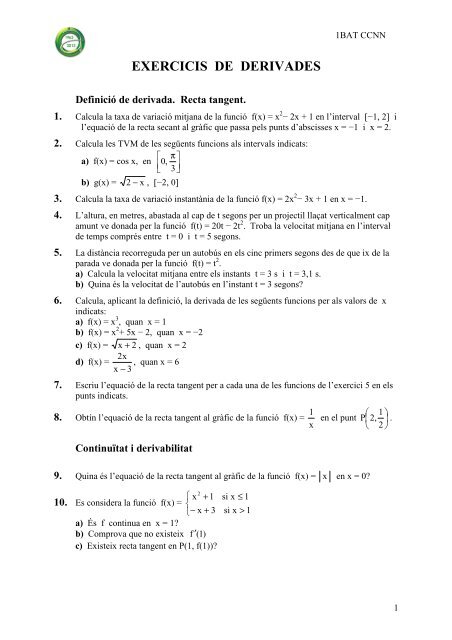
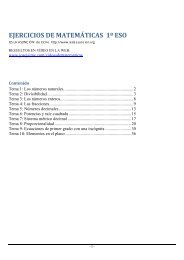
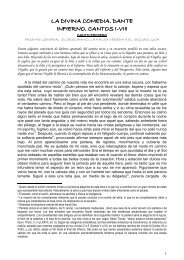
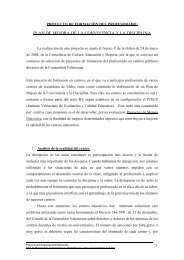

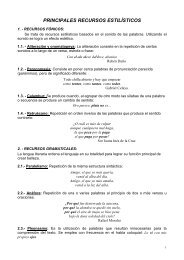
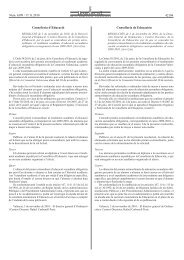
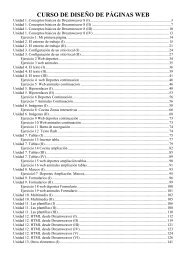
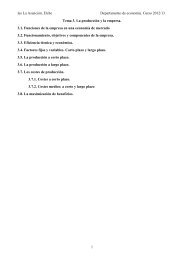
![Ejercicios de form. y deriv. [ejercicios]](https://img.yumpu.com/42668029/1/184x260/ejercicios-de-form-y-deriv-ejercicios.jpg?quality=85)
